Technology like NFTs, VR, and blockchain is transforming the art market by making ownership more transparent and secure. NFTs certify authenticity and scarcity, boosting buyer confidence, while blockchain provides an unchangeable record of provenance. VR creates immersive exhibitions that anyone can explore globally. These tools also expand access and foster new ways for artists and collectors to connect. If you keep exploring, you’ll discover how these innovations shape the future of art.
Key Takeaways
- NFTs certify digital art ownership, authenticity, and scarcity, increasing buyer confidence and market transparency.
- Blockchain creates tamper-proof records for artwork provenance, reducing fraud and ensuring long-term authenticity.
- VR and AR enable immersive global art experiences, expanding access and engagement beyond physical galleries.
- Digital platforms facilitate direct artist-collector interaction, fostering community and influencing creative directions.
- Technology raises legal and ethical challenges, including copyright disputes, provenance verification, and privacy concerns.
The Rise of Digital Art and NFTs
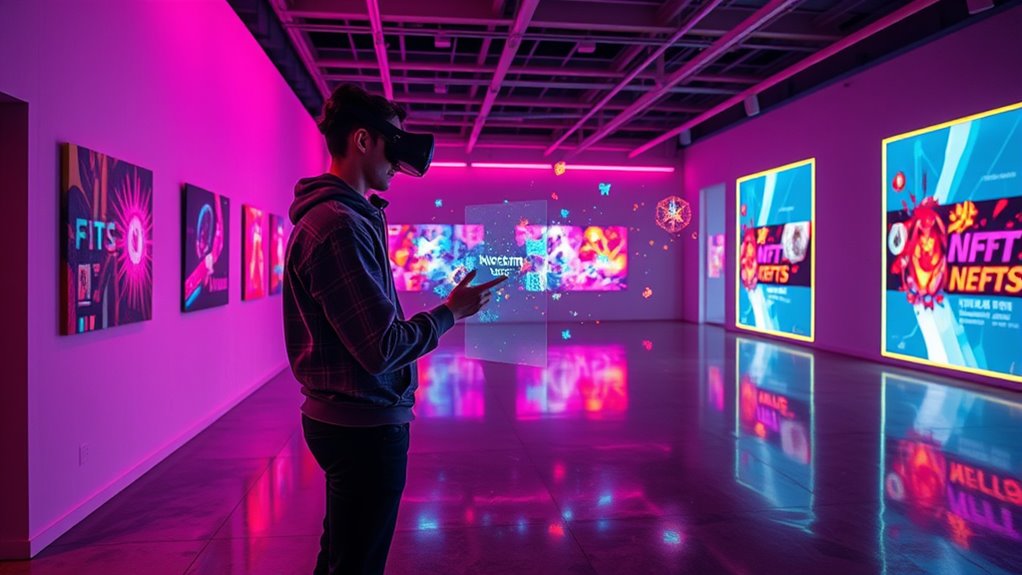
Digital art and NFTs have revolutionized the art market by making ownership and provenance more transparent and accessible. With augmented reality, you can now experience digital artworks in your environment, blending physical and virtual worlds seamlessly. Artificial intelligence also plays a role by creating dynamic, interactive pieces that adapt to viewer input. These innovations allow artists to push creative boundaries and reach global audiences instantly. NFTs certify digital ownership, giving buyers confidence in authenticity and scarcity. You can browse, buy, and showcase art from anywhere, transforming traditional galleries into virtual spaces. As technology evolves, digital art becomes more immersive and personalized, making art collecting more engaging and inclusive for everyone. Additionally, the integration of blockchain technology enhances asset management by providing secure, transparent records of ownership and transaction history. This shift is redefining how you perceive, own, and interact with art in the digital age.
How Blockchain Ensures Authenticity and Provenance
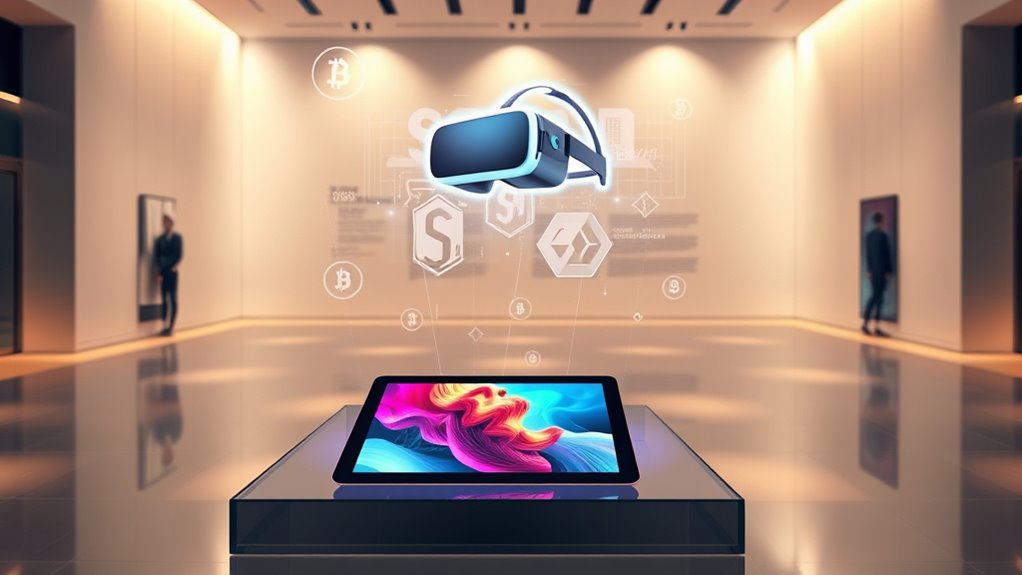
Blockchain creates an unchangeable record that verifies an artwork’s history, making it impossible to alter or falsify. It also provides a transparent chain of ownership, so you can easily trace where the piece has been. Additionally, secure digital certificates confirm authenticity, giving you confidence in each transaction. Moreover, integrating digital authentication techniques enhances trust and reduces counterfeit risks in the art market.
Immutable Record Keeping
Immutable record keeping has revolutionized how the art market verifies the authenticity and provenance of artworks. Blockchain creates an unchangeable ledger, ensuring that every transaction is permanently recorded. When you register an artwork, digital signatures confirm its authenticity, linking the piece to its creator securely. Data encryption protects this information from tampering, making unauthorized alterations impossible. This transparency means you can trust that the provenance details are accurate and unaltered over time. Every update or transfer is timestamped and stored immutably, preventing forgery or disputes. With this technology, the art market gains a reliable, tamper-proof record of an artwork’s history, giving you confidence in its legitimacy and ownership throughout its lifespan. Additionally, quality control measures help maintain the integrity of the records, ensuring consistent standards across the industry.
Transparent Ownership Chain
How can you be sure that an artwork’s ownership history is genuine and unbroken? Blockchain creates a transparent ownership chain, making it easier to verify provenance. Every transaction related to the artwork is recorded on the blockchain, providing clear, tamper-proof proof of ownership history. This ownership transparency allows collectors, dealers,, and institutions to trace the piece back to its origins without relying on paper records that can be lost or forged. Provenance verification becomes straightforward because each transfer of ownership is publicly accessible and immutably stored. As a result, blockchain not only enhances trust but also reduces the risk of fraud, ensuring that everyone involved can confidently confirm an artwork’s authenticity through its unalterable, verified ownership chain. Storage in a cool, dark place can help preserve associated digital certificates, ensuring long-term authenticity.
Secure Digital Certificates
Have you ever wondered how you can be certain that an artwork’s certificate of authenticity is genuine? Blockchain creates secure digital certificates by using digital signatures that verify the creator’s identity. Data encryption protects this information from tampering, ensuring the certificate remains intact and trustworthy. When you access a blockchain-based certificate, you’re seeing an immutable record of provenance that can’t be altered or forged. This transparency builds confidence and trust in the artwork’s authenticity. Regular maintenance and technological updates may further enhance the security and efficiency of blockchain verification systems. Water usage costs and the environmental impact are also considerations when evaluating modern technological solutions.
Virtual Reality: Transforming Art Exhibitions

Virtual reality is revolutionizing how you experience art exhibitions by creating immersive gallery visits from anywhere. It breaks down barriers, making art accessible to a global audience that might not otherwise have the chance to see it in person. As a result, VR expands the reach and impact of art like never before. Additionally, integrating digital assets like NFTs with VR art experiences offers new opportunities for artists and collectors to authenticate and showcase digital artworks in a virtual space.
Immersive Gallery Experiences
Immersive gallery experiences are revolutionizing the way audiences engage with art by leveraging virtual reality technology. You can now explore curated exhibitions from anywhere, immersing yourself in virtual curation that feels incredibly real. These experiences transform traditional viewing into immersive storytelling, allowing you to step inside masterpieces and discover new layers of meaning. Feel the awe as you walk through a virtual gallery, connecting emotionally with art on a personal level. This technology stirs curiosity, wonder, and an emotional connection you might not find in physical spaces. Virtual reality makes art more accessible, engaging, and emotionally impactful, opening doors to experiences that were once impossible. Prepare to be moved like never before as you become part of the art itself. Advances in nanoscience are also contributing to the development of more realistic and immersive visual displays, enhancing the virtual art experience.
Accessibility and Global Reach
By removing physical barriers, virtual reality broadens access to art exhibitions, allowing people worldwide to experience masterpieces without leaving their homes. This technology enhances global accessibility, enabling audiences from diverse backgrounds to engage with art regardless of location. Virtual reality creates opportunities for cross-cultural exchange, connecting viewers with artworks and cultures they might never encounter in traditional settings. You can explore international galleries and attend exhibitions across continents, fostering a deeper understanding of different artistic traditions. This democratization of art breaks down geographic and economic barriers, making high-quality cultural experiences available to everyone. Additionally, integrating artistic diversity through VR can enrich the viewer’s understanding of various cultural narratives. As a result, VR transforms the art world into a more interconnected space, encouraging broader participation and enriching the global art community through shared experiences.
Impact of Technology on Artist and Collector Dynamics

Technology has fundamentally transformed how artists and collectors interact, making the art world more accessible and dynamic. You now have new ways to engage with artists through digital platforms, fostering direct artist collaborations that break traditional barriers. As a collector, your engagement is more immediate and personal, allowing you to support emerging talents and influence creative directions. This shift creates a sense of community and shared purpose, empowering both artists and collectors alike. Additionally, the integration of privacy policies ensures that your personal data and browsing experience are protected as you explore these innovative opportunities.
Challenges and Controversies Surrounding Digital Art
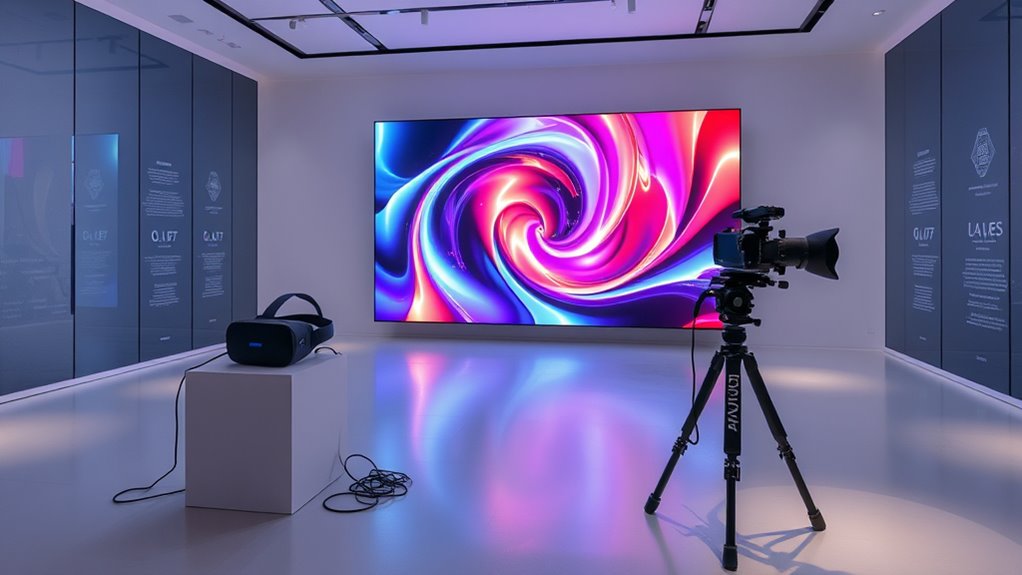
While digital platforms have opened new avenues for artistic expression and interaction, they also bring significant challenges and controversies. One major issue is copyright disputes, as artists often struggle to protect their work from unauthorized use or copying in the digital sphere. Digital vandalism, where artworks are intentionally altered or defaced online, raises concerns about the integrity and authenticity of digital art. These problems can undermine trust in digital art markets and complicate ownership rights. Additionally, the ease of duplication makes it harder to verify provenance, fueling debates over authenticity. Understanding issues such as provenance verification and the importance of clear ownership rights can help you navigate this complex landscape. As you navigate this space, understanding these challenges helps you appreciate the complexities artists and collectors face, highlighting the need for better protections and clearer regulations in the evolving digital art landscape.
The Future of Physical Versus Digital Art Spaces
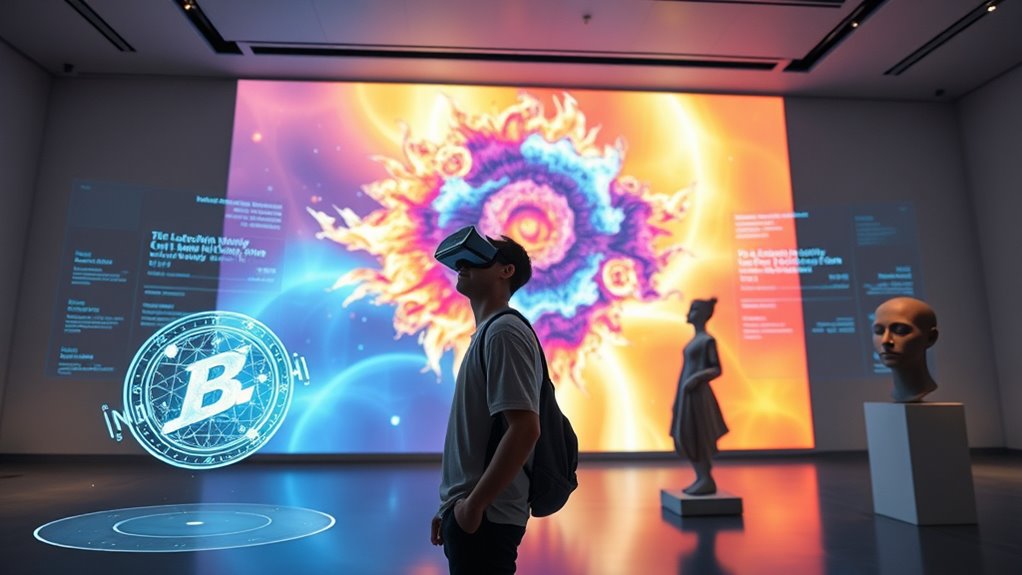
As digital innovations continue to reshape how we experience and acquire art, the future of physical and digital art spaces becomes an increasingly intertwined landscape. You’ll notice that physical gallery preservation remains essential, offering tangible experiences that digital art can’t fully replicate. Digital spaces expand access and create new ways to showcase art, but they challenge traditional art valuation methods rooted in physicality and provenance. This evolving dynamic invites you to contemplate how authenticity and emotional connection will define future art interactions. As both domains grow closer, the value of physical presence might shift, but it will still hold a special place in art history. Your role is to navigate this hybrid future, appreciating both the enduring significance of physical galleries and the limitless possibilities of digital innovation. Understanding the importance of contrast ratio and image quality in digital displays can enhance how art is experienced across these spaces.
Legal and Ethical Considerations in Tech-Driven Art Markets
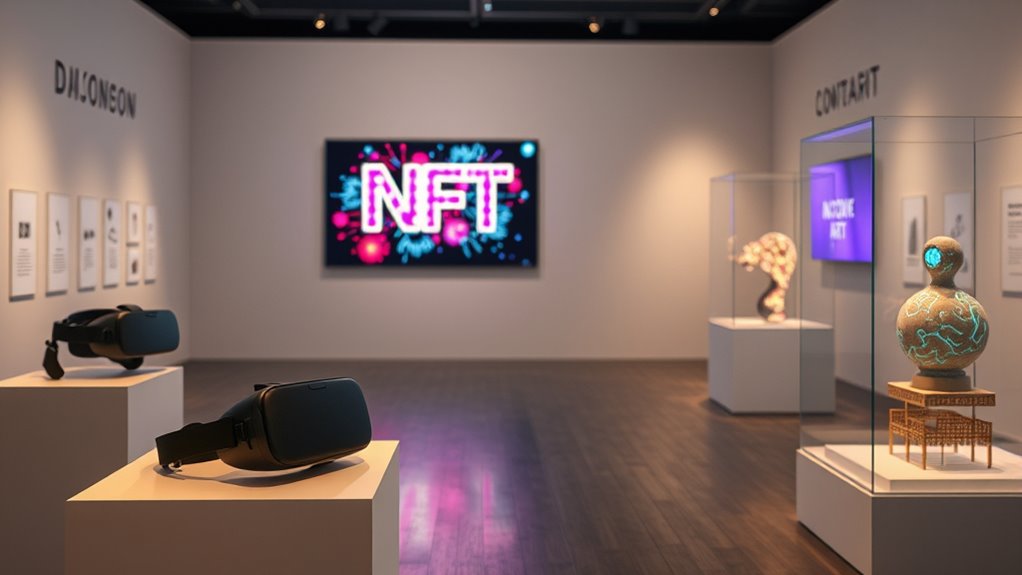
The integration of digital innovations into the art market raises complex legal and ethical questions that demand careful attention. You need to be aware of copyright infringement risks, especially with digital reproductions and NFTs, where ownership rights can be unclear or easily violated. Privacy concerns also come into play, as platforms collecting user data may mishandle personal information or enable unauthorized tracking. As an artist or collector, you must navigate these issues to avoid legal pitfalls and protect your rights. Ethical considerations include ensuring transparency around digital provenance and respecting intellectual property. Staying informed about evolving laws and best practices helps you safeguard your investments and uphold integrity in this rapidly changing digital landscape. Additionally, understanding AI Security principles can help protect digital assets from cyber threats and unauthorized access.
Emerging Trends and Opportunities in the Digital Art Realm
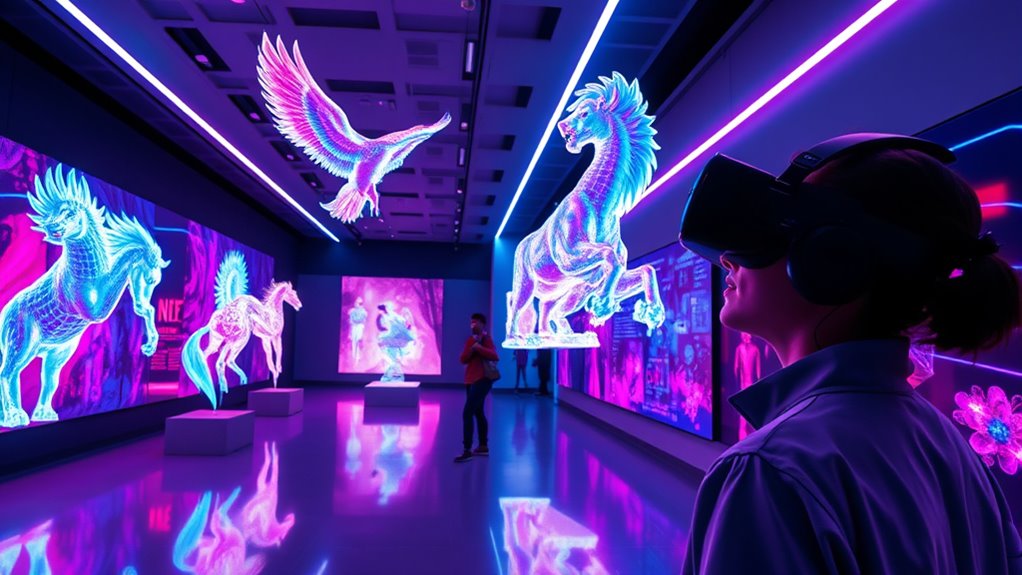
Rapid advancements in digital technology are opening exciting new opportunities for artists and collectors alike. AI curation is transforming how you discover and appreciate art, offering personalized collections tailored to your tastes. Digital restoration lets you revive and preserve masterpieces, making them accessible for future generations. These innovations create immersive experiences through VR and blockchain, expanding your engagement with art. You can now own authentic digital assets or explore virtual galleries from anywhere. The market evolves with emerging trends like AI-driven curation, which enhances discovery, and digital restoration, which maintains the integrity of artworks. This landscape is shifting rapidly, offering you innovative ways to connect with art and expand your collection. Harnessing Strategy and Mastery through AI-powered content clusters can further enhance your understanding and engagement with these digital art innovations. Embrace these opportunities to shape your experience in the vibrant digital art sphere.
Frequently Asked Questions
How Do Digital Art Royalties Work in Blockchain Platforms?
You receive digital art royalties through blockchain platforms via royalty distribution, which automatically pays you a percentage of sales each time your art is resold. Smart contract enforcement guarantees these payments happen seamlessly and transparently, without needing intermediaries. When your artwork is sold, the smart contract automatically triggers the royalty payout, guaranteeing you get your fair share whenever the art changes hands.
What Privacy Concerns Arise From Blockchain-Based Art Transactions?
You might worry about privacy concerns with blockchain-based art transactions, primarily around data security and user anonymity. While blockchain offers transparency, it can also expose transaction details, potentially linking your identity to your digital art activities. This means your personal data could be at risk if not properly protected. Ensuring strong security measures and using privacy-focused platforms helps maintain your anonymity and keeps your data safe.
Can Virtual Reality Art Experiences Replace Traditional Galleries Entirely?
Virtual reality art experiences can’t fully replace traditional galleries, but they do offer unique advantages. You can explore virtual galleries and immersive exhibitions from anywhere, making art more accessible. However, the physical presence and social atmosphere of traditional galleries provide a different experience that virtual spaces can’t replicate. While VR enhances accessibility and interactivity, it complements rather than replaces the tangible connection you get in physical art spaces.
How Do Copyright Laws Adapt to NFT Ownership?
You might think copyright laws are a fixed lighthouse, but with NFTs, they’re more like a shifting tide. As digital authentication becomes the new gatekeeper, laws adapt to clarify ownership transfer and protect creators’ rights. You need to stay alert, as legal frameworks evolve to match this digital frontier, ensuring that owning an NFT doesn’t mean losing control. This ongoing adaptation helps artists and collectors navigate the complex waters of digital ownership.
What Environmental Impacts Are Associated With Blockchain Networks?
You should know that blockchain networks consume significant energy, mainly due to energy consumption involved in mining processes. This high energy use contributes to environmental impacts like increased carbon emissions. Additionally, electronic waste is a concern as outdated mining hardware accumulates. These environmental impacts highlight the need for more sustainable blockchain practices, encouraging you to support eco-friendly solutions and innovations that reduce energy consumption and electronic waste.
Conclusion
As you navigate this digital art revolution, remember that technology is both a brush and a canvas, painting new horizons while challenging old boundaries. Embrace the innovations like NFTs, VR, and blockchain—they’re shaping a future where art is more accessible and authentic than ever. While obstacles remain, your role as a creator or collector is to harness these tools wisely, steering this vibrant digital renaissance toward a horizon filled with endless possibility.









